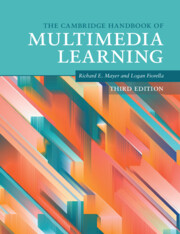Book contents
- The Cambridge Handbook of Multimedia Learning
- The Cambridge Handbook of Multimedia Learning
- Copyright page
- Contents
- Figures
- Tables
- Contributors
- Preface
- Acknowledgments
- Part I Background
- 1 Introduction to Multimedia Learning
- 2 Foundations of Multimedia Learning
- 3 Fifteen Common but Questionable Principles of Multimedia Learning
- 4 Research Methods in Multimedia Learning
- Part II Theoretical Foundations
- Part III Basic Principles of Multimedia Learning
- Part IV Principles for Reducing Extraneous Processing in Multimedia Learning
- Part V Principles for Managing Essential Processing in Multimedia Learning
- Part VI Principles Based on Social and Affective Features of Multimedia Learning
- Part VII Principles Based on Generative Activity in Multimedia Learning
- Part VIII Multimedia Learning with Media
- Author Index
- Subject Index
- References
3 - Fifteen Common but Questionable Principles of Multimedia Learning
from Part I - Background
Published online by Cambridge University Press: 19 November 2021
- The Cambridge Handbook of Multimedia Learning
- The Cambridge Handbook of Multimedia Learning
- Copyright page
- Contents
- Figures
- Tables
- Contributors
- Preface
- Acknowledgments
- Part I Background
- 1 Introduction to Multimedia Learning
- 2 Foundations of Multimedia Learning
- 3 Fifteen Common but Questionable Principles of Multimedia Learning
- 4 Research Methods in Multimedia Learning
- Part II Theoretical Foundations
- Part III Basic Principles of Multimedia Learning
- Part IV Principles for Reducing Extraneous Processing in Multimedia Learning
- Part V Principles for Managing Essential Processing in Multimedia Learning
- Part VI Principles Based on Social and Affective Features of Multimedia Learning
- Part VII Principles Based on Generative Activity in Multimedia Learning
- Part VIII Multimedia Learning with Media
- Author Index
- Subject Index
- References
Summary
The chapter begins with a quick summary and research update on earlier lists of 10 questionable multimedia principles. We then add five additional principles that have gained traction in recent years. The updated 10 former questionable beliefs include the unfulfilled expectations that multimedia instruction: (1) yields more learning than live instruction or older media, (2) is more motivating than other instructional media, (3) provides animated pedagogical agents that aid learning, (4) accommodates different learning styles and so maximizes learning for more students; and also benefits learning by allowing and encouraging (5) student managed constructivist and discovery approaches, (6) autonomy and control over the sequencing of instruction, (7) higher order thinking skills, (8) incidental learning of enriching information, (9) interactivity, and (10) authentic learning environments and activities.
Keywords
- Type
- Chapter
- Information
- The Cambridge Handbook of Multimedia Learning , pp. 25 - 40Publisher: Cambridge University PressPrint publication year: 2021
References
- 1
- Cited by



